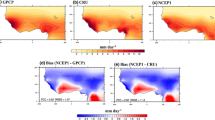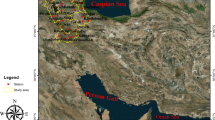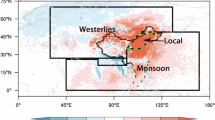Abstract
The northward propagating intraseasonal Oscillation (ISO) is one of the dominant modes of tropical variability during Boreal summers. Several mechanisms have been proposed to explain northward propagation. Yet the factors that decide the ISO rainfall over a particular region remain elusive. This study shows that the ISO rainfall anomalies weaken across the south Bay of Bengal (SBoB) before they re-strengthen over the north Bay of Bengal (NBoB). We use the moisture budget to understand the reason for these weakening-strengthening cycles. We find that the horizontal moisture flux convergence (MFC) predominantly controls the ISO rainfall anomalies over the two regions. The convergence of background moisture by the ISO wind perturbations decides the ISO rainfall structure. Since past literature suggests that the Planetary Boundary Layer (PBL) convergence is caused by barotropic vorticity, we further conduct the vorticity budget to understand the rainfall structure. We find that though vorticity tilting helps generate the positive tendency of the ISO vorticity, the vorticity stretching enhances it. Further splitting of the stretching term helps us conclude that the convergence due to wind perturbations is the predominant term, representing feedback between dynamics and thermodynamics. We hypothesize that the weaker rainfall anomalies in the SBoB result from the weaker background column relative humidity and moisture, which do not allow the initial dynamic perturbations to grow as fast as they do in an environment with stronger background relative humidity and moisture (NBoB). Our study helps us understand the factors that control the ISO rainfall over a particular region and could help improve the model simulations.














Similar content being viewed by others
Data availability
ERA5 data used in this study can be obtained from https://climate.copernicus.eu/climate-reanalysis, and TRMM rainfall data can be downloaded from https://disc.gsfc.nasa.gov/datasets/TRMM_3B42_Daily_7/summary.
Code availability
All the codes used in this study were written in NCAR Command Language (NCL). Though they are written specifically for this study, they will be provided to anyone on a request to the author through an e-mail.
Notes
Since ISO signal is very robust in the Equatorial Indian ocean, the choice of region does not make any difference in constructed composite.
Since most of our region of interest is over the Ocean these errors is unlikely to change findings of our work.
References
Adames AF (2017) Precipitation budget of the Madden-Julian oscillation. J Atmos Sci. https://doi.org/10.1175/JAS-D-16-0242.1
Adames AF, Kim D (2016) The MJO as a dispersive, convectively coupled moisture wave: theory and observations. J Atmos Sci 73:913–941. https://doi.org/10.1175/JAS-D-15-0170.1
Adames A, Ming Y (2018a) Interactions between water vapor and potential vorticity in synoptic-scale monsoonal disturbances: moisture vortex instability. J Atmos Sci. https://doi.org/10.1175/JAS-D-17-0310.1
Adames A, Ming Y (2018b) Moisture and moist static energy budgets of south Asian monsoon low pressure systems in gfdl am4.0. J Atmos Sci. https://doi.org/10.1175/JAS-D-17-0309.1
Adames AF, Wallace JM (2015) Three-dimensional structure and evolution of the moisture field in the MJO. J Atmos Sci 72:3733–3754. https://doi.org/10.1175/JAS-D-15-0003.1
Adames A, Scottw P, Ahmed F et al (2021) Tropical precipitation evolution in a buoyancy-budget framework. J Atmos Sci. https://doi.org/10.1175/JAS-D-20-0074.1
Ahmed F, Schumacher C (2015) Convective and stratiform components of the precipitation-moisture relationship. GRL. https://doi.org/10.1002/2015GL066957
Arushi P, Chakraborty A, Nanjundiah R (2017) Orographic control of the Bay of Bengal cold pool rainfall. J Earth Syst Sci. https://doi.org/10.1007/s12040-017-0892-1
Back LE, Bretherton CS (2009) On the relationship between SST gradients, boundary layer winds, and convergence over the tropical oceans. J Clim. https://doi.org/10.1175/2009JCLI2392.1
Baosheng L, Zhou L, Lian T et al (2023) Impact of sea surface temperature gradient on monsoon intraseasonal oscillation. J Clim 36:1161–1173. https://doi.org/10.1175/JCLI-D-22-0329.1
Bretherton CS, Peters ME, Back LE (2004) Relationships between water vapor path and precipitation over the tropical oceans. J Clim. https://doi.org/10.1175/1520-0442(2004)017<1517:RBWVPA>2.0.CO;2
Das U, Vinayachandran P, Behara A (2016) Formation of the southern Bay of Bengal cold pool. Clim Dyn. https://doi.org/10.1007/s00382-015-2947-9
Drobholav HKL, Wang B (2005) Mechanism of the northward-propagating intraseasonal oscillation: insights from a zonally symmetric model. J Clim 18:952–972. https://doi.org/10.1175/JCLI3306.1
Goswami NB (2005) South asian monsoon. In: Intraseasonal variability in the atmosphere-ocean climate system. Springer, pp 19–61
Goswami B, Sengupta D, Kumar GS (1998) Intraseasonal oscillations and interannual variability of surface winds over the Indian monsoon region. Proc Indian Acad Sci (Earth Planet Sci). https://doi.org/10.1007/BF02842260
Hersbach H, Bell B, Berrisford P et al (2020) The era5 global reanalysis. Q J Roy Met Soc 146(730):1999–2049. https://doi.org/10.1002/qj.3803
Holloway CE, Neelin JD (2009) Moisture vertical structure, column water vapor, and tropical deep convection. J Atmos Sci. https://doi.org/10.1175/2008JAS2806.1
Huffman G, Bolvin D, Nelkin E et al (2007) The trmm multi-satellite precipitation analysis (tmpa). Satellite Rainfall Appl Surf Hydrol 20:3–22
Huffman G, Alder R, Bolvin D et al (2007) The trmm multisatellite precipitation analysis (tmpa): quasi-global, multiyear, combined-sensor precipitation estimates at fine scales. J Hydrometeorol 8:38–55. https://doi.org/10.1175/JHM560.1
Jiang X (2017) Key processes for the eastward propagation of the Madden-Julian oscillation based on multimodel simulations. J Geophys Res Atmos 122:755–770. https://doi.org/10.1002/2016JD025955
Jiang X, Adames A, Zhao M et al (2018) A unified moisture mode framework for seasonality of the Madden Julian oscillation. J Clim 31:4215–4224. https://doi.org/10.1175/JCLI-D-17-0671.1
Jiang X, Li T, Wang B (2004) Structures and mechanisms of the northward propagating boreal summer intraseasonal oscillation. J Clim 17:1022–1039. (1520-0442(2004)017<1022:SAMOTN>2.0.CO;2)
Karmakar N, Misra V (2020) Differences in northward propagation of convection over the Arabian sea and Bay of Bengal during boreal summer. J Geophys Res. https://doi.org/10.1029/2019JD031648
Karmakar N, Chakraborty A, Nanjundiah RS (2017) Space-time evolution of the low- and high-frequency intraseasonal modes of the Indian summer monsoon. Mon Weather Rev 145(2):413–435. https://doi.org/10.1175/MWR-D-16-0075.1
Karmakar N, Susmitha J, Atul SK (2022) Northward propagation of convection over Arabian sea and Bay of Bengal: a perspective from vorticity equation. Clim Dyn. https://doi.org/10.1007/s00382-022-06248-7
Kembell-cook S, Wang B (2001) Equatorial waves and air-sea inter-action in the boreal summer intraseasonal oscillation. J Clim 14:2923–2942. https://doi.org/10.1175/1520-0442(2001)014<2923:EWAASI>2.0.CO;2
Kottapalli A, Vinayachandran PN (2022) On the weakening of northward propagation of intraseasonal oscillations during positive Indian ocean dipole events. Clim Dyn 59:915–938. https://doi.org/10.1007/s00382-022-06164-w
Krishnamurti T, Subramanyam D (1982) The 30–50 days mode at 850 mb during Monex. J Atmos Sci 39:2088–2095
Li B, Lei Z, Jianhuang Q et al (2021) The role of vorticity tilting in northward-propagating monsoon intraseasonal oscillation. GRL. https://doi.org/10.1029/2021GL093304
Li B, Lei Z, Jianhuang Q et al (2022) Maintenance of cyclonic vortex during monsoon intraseasonal oscillation: a view from kinetic energy budget. GRL. https://doi.org/10.1029/2022GL097740
Lindzen R, Nigam S (1987) On the role of sea surface temperature gradients in forcing low-level winds and convergence in the tropics. J Atmos Sci. https://doi.org/10.1175/1520-0469(1987)044<2418:OTROSS>2.0.CO;2
Masunaga H (2012) Short-term versus climatological relationship between precipitation and tropospheric humidity. J Clim. https://doi.org/10.1175/JCLI-D-12-00037.1
Misra V, Pantina P, Chan SC et al (2012) A comparative study of the Indian summer monsoon hydroclimate and its variations in three reanalyses. Clim Dyn. https://doi.org/10.1007/s00382-012-1319-y
Misra V, Mishra A, Bhardwaj A (2018) Simulation of the intraseasonal variations of the Indian summer monsoon in a regional coupled ocean-atmosphere model. J Clim. https://doi.org/10.1175/JCLI-D-17-0434.1
Peter CB, David MS (2005) The use of moisture flux convergence in forecasting convective initiation: historical and operational perspectives. Wea Forecast. https://doi.org/10.1175/WAF858.1
Raymond D (2000) The hadley circulation as a radiative-convective instability. J Atmos Sci. https://doi.org/10.1175/1520-0469(2000)057<1286:THCAAR>2.0.CO;2
Shankar D, Shetye SR, Joseph PV (2007) Link between convection and meridional gradient of sea surface temperature in the Bay of Bengal. J Earth Syst Sci. https://doi.org/10.1007/s12040-007-0038-y
Sijikumar S, John L, Manjusha (2013) Sensitivity study on the role of western ghats in simulating the Asian summer monsoon characteristics. Meteorol Atmos Phys 120:53–60. https://doi.org/10.1007/s00703-013-0238-8
Sikka D, Gadgil S (1980) On the maximum cloud zone and the itcz over Indian longitudes during the southwest monsoon. Mon Weather Rev 108:1840–1853
Sobel A, Maloney E (2012) An idealized semi-empirical framework for modeling the Madden-Julian oscillation. J Atmos Sci 69:1691–1705. https://doi.org/10.1175/JAS-D-11-0118.1
Sobel A, Maloney E (2013) Moisture modes and the eastward propagation of the MJO. J Atmos Sci 70:187–192. https://doi.org/10.1175/JAS-D-11-0118.1
Sobel A, Maloney E, Bellon G (2008) The role of surface heat fluxes in tropical intraseasonal oscillations. Nature Geosci 1:653–657. https://doi.org/10.1038/ngeo312
Wang B, Webster PJ, Teng H (2005) Antecedents and self-induction of active-break south Asian monsoon unraveled by satellites. Geophys Rese Lett. https://doi.org/10.1029/2004GL020996
Wang B, Xie X (1997) Model for the boreal summer intra-seasonal oscillation. J Atmos Sci 54:72–86. https://doi.org/10.1175/1520-0469(1997)054<0072:AMFTBS>2.0.CO;2
Yasunari T (1979) Cloudiness fluctuations associated with the northern hemisphere summer monsoon. J Meteorol Soc Jpn 57:227–242
Zhang C, Adames AF, Khouider B et al (2020) Four theories of the Madden-Julian oscillation. Rev Geophys. https://doi.org/10.1029/2019RG000685
Acknowledgements
AK acknowledges financial support from MHRD Govt. India, and Grantham fellowship. PNV acknowledges partial financial support from J C Bose Fellowship, DST, Govt. of India. The authors acknowledges the Corpenicus site for ERA5 data set, and NASA for TRMM data. The authors would also like to thank two anonymous reviewers whose valuable suggestions helped enhance the manuscript’s quality and readability. AK acknowledges his colleague Rajat Masiwal for his conversations throughout, which immensely helped us in this work.
Funding
AK has financial support from MHRD Government of India (GOI) and Grantham fellowship. PNV has financial support from J C Bose Fellowship, DST, Govt. of India.
Author information
Authors and Affiliations
Contributions
AK and PNV conceptualized the problem, AK has done the data collection, analysis, writing the manuscript. PNV edited the manuscript.
Corresponding author
Ethics declarations
Conflict of interest
The authors declare no competing interests.
Additional information
Publisher's Note
Springer Nature remains neutral with regard to jurisdictional claims in published maps and institutional affiliations.
Supplementary Information
Below is the link to the electronic supplementary material.
Appendices
Appendix A: Conversion of kgm\(^{-2}\text {s}^{-1}\) to mmday\(^{-1}\)
Noting that 1 kg of water occupies a volume of 1000 cm\(^3\) which is equal to \(10^{-3} \hspace{2mm} \text {m}^3\). A kg of water spread uniformly over an area of \(m^2\) will be 1 mm high. Thus, 1 kgm\(^{-2}\) of rain is equivalent to 1 mm of rainfall. And noting one day has approximately 86,400 s, Thus, we need to just multiply the value in kgm\(^{-2}s^{-1}\) by 86,400 to convert into mmday\(^{-1}\).
Appendix B: Relation between pressure vertical velocity and the convergence
Starting from the continuity equation continuity equation \(\frac{\partial u}{\partial x} + \frac{\partial v}{\partial y}+\frac{\partial \omega }{\partial p} = 0\), noting that both the background and the anomalous components of velocities individually satisfy the continuity, when we integrate the above equation for the ISO winds, between the surface level \(p_s\) and any other level p we get:
If we assume that vertical velocity at the surface is negligible (which is generally the case), we get:
Which states that vertical velocity at any pressure level p, is equal to the vertical integral of convergence from the surface pressure (\(p_s\))to that level p.
Appendix C: The vorticity budget
The vorticity equation in pressure coordinate system takes the form:
where \(\zeta = \frac{\partial v}{\partial x} - \frac{\partial u}{\partial y}\) is the z-component of vorticity and “\(\Biggl \langle \Biggl \rangle\)” represents the vertical integration from the surface pressure \(p_s\) to 200 hpa level (Karmakar et al. 2022).
Rights and permissions
Springer Nature or its licensor (e.g. a society or other partner) holds exclusive rights to this article under a publishing agreement with the author(s) or other rightsholder(s); author self-archiving of the accepted manuscript version of this article is solely governed by the terms of such publishing agreement and applicable law.
About this article
Cite this article
Kottapalli, A., Vinayachandran, P.N. A possible feedback between dynamics and thermodynamics through the background moisture in dictating the ISO rainfall over the Bay of Bengal. Clim Dyn 62, 123–140 (2024). https://doi.org/10.1007/s00382-023-06897-2
Received:
Accepted:
Published:
Issue Date:
DOI: https://doi.org/10.1007/s00382-023-06897-2




